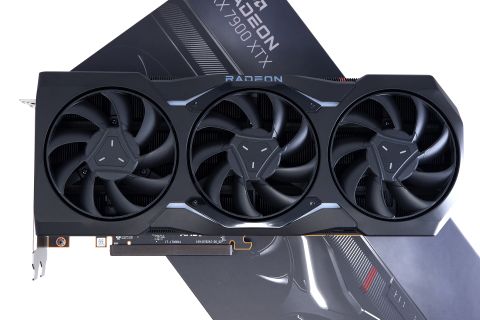Our Verdict
The RX 7900 XTX is not a direct competitor to the RTX 4080 in every way, but it's notably cheaper and delivers a whole lot more than the top RX 6000-series card.
For
- Much faster than an RX 6950 XT at 4K
- Less power hungry too
- $999 price tag
- Much improved ray tracing capabilities
- Frickin' chiplets!
Against
- Not a consistent RTX 4080 competitor
- Runs real hot
- Consumes a lot of power
- Low average clock speed
PC Gamer's got your back
Update: Our review RX 7900 XTX sample suffered from an issue with GPU hotspot temperatures exceeding the normal expected range under load. We've since been in contact with AMD about a replacement for retesting, which we've since received, but unfortunately we've had the same issue strike again.
We recommend you instead check out our reviews for the Asus TUF Gaming Radeon RX 7900 XTX OC Edition and Sapphire Nitro+ RX 7900 XTX Vapor-X, as these cards are entirely unaffected by the issue and better show what sort of performance you can expect from this card's spec.
Original review: The AMD Radeon RX 7900 XTX has a lot going for it. We're used to seeing GPU generations that arrive on smaller process nodes, redesigned architectures, larger caches, reworked shaders, more memory—the list goes on. But all of that, all at once? That's what RDNA 3 delivers: the whole lot in one fell swoop.
The RX 7900 XTX is the best example of the all-encompassing upgrade to the Radeon DNA, and it's a mighty 4K card for those improvements. Just one of the new things introduced with this graphics card may be one of the most significant changes in manufacturing and design that we've seen in a very long time: a chiplet-based GPU. I feel I've been waiting for years to say that in reference to a gaming card and yet this past week I've actually been playing games on a chip that's made up of interconnected silicon wafers all working together seamlessly as one.
Though the RX 7900 XTX parachutes in as a prohibitively expensive card at $999. It's certainly not for everyone at that price. The $899 RX 7900 XT sits below this card and offers a pared back number for less, but not by much. At the very least you are getting the best of the best for your money with the RX 7900 XTX, and sort-of price parity with the previous generation, which can't be said for its fiercest competition from team green.
With AMD and Nvidia focusing on the high-end with their first cards of a new generation, it comes down to where best to spend that $1,000 or more you have lying around. Is it AMD's new chiplet GPU that will win you over, or shall you find the allure of the more stable performance of Nvidia's Ada Lovelace to be worth the extra cash? The answer, as ever, is complicated.
AMD RX 7900 XTX architecture
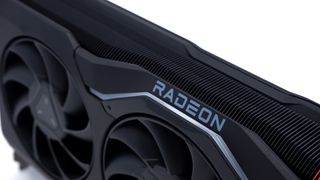
What's new in the RDNA 3 architecture?
The Navi 31 GPU powering the RX 7900 XTX is pretty special. Rather than stuffing ever-growing amounts of circuitry onto a single slab of silicon—the go-to approach for, well, every modern gaming GPU thus far—the Navi 31 GPU is actually seven discrete, smaller slabs of silicon.
That's seven individual chips all working together as one to provide a high-end ultra-enthusiast gaming experience: One Graphics Die (GCD) and six Memory Cache Dies (MCDs).
Think of RDNA 3 as a translation of what AMD's achieved with chiplets in the CPU world with its Ryzen chips—two chiplets connected by a high-bandwidth interconnect. The thing is when it comes to the graphics world you need an even bigger interconnect and even more chips chocked-full of transistors to get the job done.
Let's start with the biggest chip of the lot, the GCD. The GCD is the largest component inside the Navi 31 GPU at 300mm2. When I say largest, it is comparatively tiny compared to a monolithic GPU of a similar calibre today. Consider the RTX 4090's gargantuan GPU at 608mm2 and AMD's new GCD sounds paltry by comparison.
The GCD is the only 5nm component in the Navi 31 GPU, built using TSMC's N5 process node.

Within the GCD lies the foundational computational cores that power the AMD RDNA 3 gaming experience, the Compute Units (CUs). Much like in RDNA 2, these are divided up into Dual Compute Units, which means they share access cache and memory, though most of their constituent parts are discrete to each CU.
Each CU contains 64 Stream Processors (SPs). These are the driving force behind rasterised gaming performance on any AMD GPU. From the AMD Dual CU diagram you can see a basic outline of the upgraded CU in all its glory.

With RDNA 3, AMD brags a 2.7x increase in shader FLOPs (floating point operations per second) versus RDNA 2. That's despite fitting the RX 7900 XTX with only 20% more cores than the RX 6950 XT. 'How's that achieved?' I hear you ask. Well, it comes down to greater power and silicon management, via clock and utilisation improvements, but also a significant change to the RDNA 3 shader core.
With RDNA 3, each SP has seen a significant overhaul, leading to much enhanced instruction throughput.
Within a CU there are two important blocks for chomping through maths to render a frame: Float / INT / Matrix SIMD32 and Float / Matrix SIMD 32. There are other new things stuffed in there, like the AI Matrix Accelerator, but it's these blocks, essentially huddles of Arithmetic Logic Units (ALUs), that make this RDNA 3 graphics card tick. These chomp through two types of number format: floating point and integer.
One new thing within the Navi 31 GPU is the inclusion of the second block, the one named Float / Matrix SIMD 32, which enables double the floating point performance where applicable. Pretty important as our much beloved videogames require shifting a lot of these numbers all at once to manifest a frame.
There are actually double the number of shaders within an RDNA 3 CU compared to RDNA 2.
What that means is one: there are actually double the number of shaders within an RDNA 3 CU compared to RDNA 2. AMD has done something similar here to what Nvidia did with its Ampere architecture. And two: we can't compare SP counts as we'd like to between the RX 7900-series cards and the RX 6000-series cards because what constitutes an SP no longer matches up gen-on-gen.
But you might remember that when Nvidia doubled its FP32 capabilities with Ampere it decided to double the listed CUDA cores for all of its Ampere and more recent GPUs. However, AMD has not done the equivalent for RDNA 3. I've tried asking AMD why it made the decision to stick with its definition of a core with RDNA 3, but I didn't receive a straightforward answer. My only assumption is that AMD wishes to stick to its definition of a core being a single SP, rather than being a count of specific FP32 units. Fair enough—I've just seen marketing departments make more of a lot less.
The key thing to note is that RDNA 3 is actually capable of a lot more than its core count lets on. Both in terms of FP32 throughput and AI acceleration—remember those extra ALUs are also handy for Matrix operations.
AMD says all-in, the new CU design leads to "approximately 17.4% architectural improvement clock for clock."
In addition to the redesigned CU, the new discrete GCD in Navi 31 has received increased cache sizes (240% more L0, 300% more L1, and 50% more L2) and higher clock speeds to deliver further improvements to the RDNA 3 shader pipeline.
Actually, clock speeds are specifically noteworthy. AMD has splintered its internal clocks with RDNA 3. There's now a shader clock and a front-end clock. According to AMD, RDNA was more front-end limited in gaming workloads, so the change benefits us gamers by allowing the front-end clock to run a little faster at 2.5GHz than the shader clock at 2.3GHz.



Now let's talk about ray tracing. AMD has a bead on what is required to build an efficient accelerator for this purpose with its own aptly-named Ray Tracing Accelerators introduced with RDNA 2. These dedicated RT blocks are back and better than ever with RDNA 3. Included with them is new hardware for specialised box sorting, aimed at pushing efficiency up for ray-traced workloads. Along with that, better utilisation techniques to extract more out of the improved RDNA 3 GCD hardware.
It's all for a pretty serious finessing of the entire RT pipeline in RDNA 3, and I have to say it's clearly working for AMD. We'll get to the performance, but AMD's focus on reducing necessary bandwidth requirements, and the pressure on ALUs to perform RT tasks, has put it on a better footing versus the competition in ray-traced games.
Right, that's the GCD, or some of it, but there are also six MCDs in the Navi 31 package.

Each MCD is a portion of the memory subsystem of the RDNA 3 GPU. It's actually a rather simple looking component next to the more complex GCD. Each MCD contains a 16MB slice of the Infinity Cache (96MB total), along with a 4 x 16-bit memory interface (384-bit total) to hook into the 24GB of GDDR6 memory close by on the PCB.
Considering the RX 6950 XT's slimmer 256-bit wide memory bus, that's a big leap in actual memory bandwidth. Effective memory bandwidth is also up with Infinity Cache factored in.
Each MCD is built using TSMC's 6nm process node. A decision aimed at reducing costs while maintaining performance. The cutting-edge 5nm node might be less power hungry or allow you to stuff more transistors into any given space but it's expensive and in high demand. Taking non-critical components off the expensive process node and dividing them between tiny 37mm2 chips makes for a much more scalable and affordable option. This scalable chiplet-based approach worked for Ryzen, so I'm hopeful that the same sort of success will drive down costs here, too. Providing that lower cost translates to more in my pocket and not just more for AMD and its stakeholders, of course.
But you can't just slice off components and stick them next to each other and hope they magically communicate. Just like a Ryzen CPU requires Infinity Fabric, a Radeon GPU requires an interconnect. And one with heaps of bandwidth at its disposal.

Sticking to its theme, AMD is introducing Infinity Links with RDNA 3. Infinity Links are a way to transfer heaps of data at a rapid pace between chiplets on the Navi 31 GPU.
Infinity Links is the part of RDNA 3 that AMD's engineers seemed the most excited to talk about during our briefings ahead of launch. And I get why. The problem was the routes of tiny wires hooking up parts of the chip package were, by comparison to everything around them, far too large to allow for effective communication across chiplets within the GPU. To solve this, AMD's engineers tasked themselves with the job of creating a new fanout technology, and that's Infinity Links.
"The bandwidth density that we achieve is almost 10x," AMD's Sam Naffziger tells us in a briefing. "And that's with the bit rates that you can see here, 9.2 gigabits per second signalling across these interfaces. And with the finer pitches of the bumps, and single routes, we get a dramatic increase in bandwidth density, which is exactly what the GPU needs."

Above: The traditional organic fanout is on the left, taken from one of AMD's server products. AMD didn't specify which, but assumedly an Epyc processor. The new Infinity Link fanout is on the right. The images are roughly to scale according to AMD.
The resulting performance is 3.5TB/s across the new interconnect, and to be able to offer that for less than 5% GPU power consumption.
Infinity Links completes the trifecta of parts that ultimately make up the Navi 31 GPU. Of course, I'm grossly oversimplifying swathes of components of the architecture, but I listened to one of AMD's best brains, Mike Mantor, talk RDNA 3 for an hour and it felt like we hardly scratched the surface. I never really stood a chance of explaining it all here. Though what I can do is actually play games on this thing, and faster frame rates in-game is ultimately what it's all leading up to.
AMD RX 7900 XTX specs

What's inside the RX 7900 XTX?
The RX 7900 XTX is the most powerful graphics card AMD has ever produced. It's no surprise that it brings with it an almighty spec sheet to drive significant gains in gaming over the previous generation. From 24GB of memory squeezed onto its surprisingly slim hull, to the 61 TFLOPs performance it's said to deliver in raw compute, the RX 7900 XTX is a beast by all measures.
| Header Cell - Column 0 | RX 7900 XTX | RX 7900 XT |
|---|---|---|
| Architecture | RDNA 3 | RDNA 3 |
| GPU | Navi 31 | Navi 31 |
| Process node | 5nm GCD + 6nm MCD | 5nm GCD + 6nm MCD |
| Transistors | 57.7B | 57.7B |
| Die size | 300mm2 GCD, 220mm2 MCD (combined) | 300mm2 GCD, 220mm2 MCD (combined) |
| Compute Units | 96 | 84 |
| Stream Processors | 6,144 | 5,376 |
| Ray Accelerators | 96 | 84 |
| AI Accelerators | 192 | 168 |
| Game clock (GHz) | 2.3 | 2 |
| Boost clock (GHz) | 2.5 | 2.4 |
| Memory | 24GB GDDR6 | 20GB GDDR6 |
| Memory bus | 384-bit | 320-bit |
| Infinity Cache | 96MB | 80MB |
| Total Board Power (watt) | 355 | 315 |
| Price (MSRP) | $999 | $899 |
The 24GB of GDDR6 memory attached to its PCB is a big step up for AMD in the memory department. The company bestowed 16GB of the stuff on its high-end RDNA 2 cards, which was wonderful at the time, and yet it's adding another 8GB here. Best be on the safe side, I suppose. That sort of capacity means there's no shortage for high resolution gaming and rapid access to assets, and that this is a graphics card more suitable for a high-performance professional workstation as a gaming PC.
Though we'll stick to gaming, thanks.
The memory chips on the RX 7900 XTX are slower compared to Nvidia's high-end RTX 40-series thus far, at just 20Gbps. The RTX 4090 and RTX 4080 use GDDR6X chips rated to 22.4Gbps and 21Gbps, respectively. That's the only real downside of the memory configuration on the XTX, as it's otherwise very generous for a card at this price.
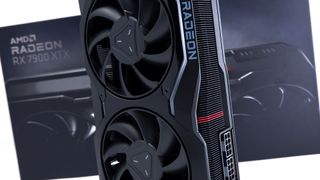
Usually how you'd compare memory on two graphics cards is by looking at the resulting memory bandwidth on offer. You take the memory interface width, multiply it by the clock, divide that by eight and you can work out just how many gigabytes can pass through a given card's memory subsystem every second. You can absolutely do that here, of course. The RX 7900 XTX, with a 384-bit bus and 20Gbps memory speed, delivers up to 960GB/s bandwidth. Compare that to the RTX 4080's 716.8GB/s and you're onto a winner with team red.
AMD likes to brag about an even bigger number, however.
AMD's "effective memory bandwidth" for the RX 7900 XTX is 3.5TB/s, significantly more than even the RTX 4090 at 1,008GB/s. But how does it make such a claim with lesser hardware? That's down to a pretty smart implementation of a large cache spread across each of the Navi 31's MCD chiplets called Infinity Cache, which you might recognise from its RDNA 2 GPUs.
That massive 3.5TB/s is no doubt a perfect scenario figure. It's based on a calculation to work out loosely what sort of theoretical bandwidth the card would need to net the same benefit as the Infinity Cache. The cache itself is not a perfect store of all the right data for the job either, there's some degree of guesswork involved. The cache itself relies on successful hits to actually retrieve pertinent data when required without heading further afield to the off-package memory. Sometimes it will also miss.

The hit rate is reportedly similar between RDNA 3 and RDNA 2, which should put it around 58% based on previous estimates from AMD. That's actually a little surprising as the RX 7900 XTX comes with 96MB of Infinity Cache, less than the RX 6950 XT's 128MB store. AMD tells us that's simply an optimisation for the second generation of Infinity Cache with RDNA 3—the rest wasn't offering as much bang for your buck in terms of silicon space used to performance gained.
The other fact that might surprise you about the RX 7900 XTX is that its core count is just 6,144. Alright, that's a lot of cores, but considering the card's claimed 2.7x single precision TFLOPs performance increase over the RX 6950 XT, a card with 5,120 cores, or 17% fewer than the RX 7900 XT, it doesn't add up.
As I've already mentioned in the architecture section, we can't compare cores in the same way as we'd like to usually with the RX 7900-series cards. There's a "bigger increase in teraflops than there is in what we call Compute Units," as AMD's Scott Olschewsky, director of product management, tells us.
The thing to take away is: more instructions per clock equals better gaming performance. And that's what the RX 7900 XTX is able to bring to the table.
The RX 7900 XTX is the most powerful graphics card AMD has ever produced.
If you can drag your eyes away from the raw gaming silicon for just a second, you'll find a shiny new feature called the Radiance Display Engine.
The Radiance Display Engine is our ticket to DisplayPort 2.1 and HDMI 2.1a support, bringing up the ability for up to 900Hz refresh rates at 1440p or 480Hz at 4K. It can also manage 165Hz at 8K. Though, let's be honest, this is all a bit over the head of any graphics card today, even one such as this.
Another notable improvement is to the Dual Media Engine in RDNA 3. This brings with it support for AV1 encode and simultaneous HEVC encode and decode of streams up to 8K60. AV1 support will likely come in handy down the line, as the video format is beginning to pick up pace in the real-world. However, it's the integration of technology from AMD's acquisition of Xilinx that aims to improve text quality at lower resolutions and low bitrates which feels the more practical upgrade for content creators.
What's special about the RX 7900 XTX reference design?

In a world of GPUs the size of cinder blocks, the RX 7900 XTX is surprisingly lean. It isn't as enormously large as the RTX 4090 or RTX 4080 in its reference garb, anyways. At just 2.5-slots and requiring only 287mm of space inside your case, it's hardly a heffalump.
The RX 7900 XTX is a pretty graphics card. I don't say that often for GPUs, in all honesty, as they all can look a bit whatever in person. That said, the RX 7900 XTX is more immediately drool-worthy, and the XT doesn't look so bad either.
The reference design is functionally fit for purpose, with a single HDMI 2.1a port, two DisplayPort 2.1 ports, and a USB Type-C port across the rear IO plate. That's AMD single handedly keeping the USB Type-C display connection alive once again, as Nvidia has shunned the connector on its GPUs since the 20-series.

There are two 8-pin power adapters on the reference card—though it's up to third-party manufacturers to follow suit or opt for the 12VHPWR connector if they so wish on their own designs. AMD's decision to stick with the older-style power adapter on its own card has nothing to do with Nvidia's poor fortune with melting 12VHPWR connectors—that decision was down to there being "no need for a new power adapter", as AMD tells me. It will have been made long before Nvidia's sorry saga began, even.
As for power delivery on the board, the RX 7900 XTX comes with a 20-stage VRM to put it up there with some top-of-the-line third-party boards. AMD couldn't skimp on these components, however, as while the XTX is not as thirsty as the RTX 4090 on average, it does gobble up a ton of power. It's technically rated to a 355W TBP—20W higher than the RX 6950 XT and 35W higher than the RTX 4080.
The RX 7900 XTX is right in the mix for power consumption and that's largely indicative of its performance, too.
AMD RX 7900 XTX performance
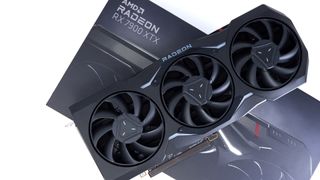
How does the RX 7900 XTX perform?
The RX 7900 XTX makes quick work of 4K gaming. It's that sort of speedy card that let's you boot up any old game in 4K and expect perfectly playable performance. The sort of graphics power that allows you to be extremely lazy and 'optimise' your game settings by turning everything up to ultra and never diving into the settings menu ever again. I love that sort of brute strength—if only because I don't like to mess with my game settings unless there's a problem.
You can be fairly liberal with ray tracing options on this AMD graphics card, too, which is the text-based equivalent of thunderous applause for AMD's second generation RT acceleration. While Nvidia tends to still pull a lead in ray-traced games, there's no need to be any more considerate about which ray tracing effects you enable and how high you crank them with AMD's latest number.
If you're dead set on firing a Star Destroyer's worth of rays across the screen, with every ray-traced effect turned to the maximum, you will experience a notable drop in performance, however. For example, Cyberpunk 2077 is tough going for the RX 7900 XTX, though it's not much easier for the RTX 4090 either. The RX 7900 XTX does, incredibly, outperform the RTX 4080 in this trying benchmark, too.
4K performance









CPU - Intel Core i9 12900K
Motherboard - Asus ROG Strix Z690-F Gaming WiFi
RAM - Trident Z 5 RGB 32GB (2x 16GB) DDR5 @5,600MHz (effective)
CPU cooler - Asus ROG Ryujin II 360mm liquid cooler
PSU - Gigabyte Aorus P1200W
Monitor - Gigabyte M32UC
For the most part when testing with ray tracing enabled on a handful of games the RX 7900 XTX was still able to push a decent frame rate. That's important, too, because while ray tracing might not be a must-have feature, if I'm spending $1,000 or more on a graphics card I really want to be able to turn on all of the latest features. You don't spend this sort of money for mediocre.
Though it is difficult to make other sweeping statements about the RX 7900 XTX's performance. In my experience, it's not an RTX 4080 demolisher, nor is it completely wiped out by Nvidia's Ada card. It's super game-dependent.
For starters, in two DirectX 11 games I tested, Warhammer III and Tiny Tina's Wonderland, the RX 7900 XTX could not keep up with the RTX 4080. AMD's card fell behind by some 8–15%.
Yet in Far Cry 6 and Cyberpunk 2077, two DirectX 12 games with a mix of light/heavy use of ray tracing, the RX 7900 XTX pulls away by 4–6%. In other DX12 games, Nvidia's still champ, often by a larger margin.
1440p performance









If you're spending this much on a graphics card, I'm assuming you are already looking at a 4K monitor. Though there's something to be said for 1440p at high refresh rates for a great blend of performance and pretty graphics, perhaps even an ultrawide. For that crowd, the RX 7900 XTX already comes close to matching a 144Hz panel frame-for-frame at 1440p.
In more competitive titles, such as Rainbow Six: Siege, the RX 7900 XTX is particularly overkill. More overkill than others? Not really, Nvidia's cards seem to be the most overkill, but overkill nonetheless.
1080p performance








The same goes for 1080p performance on the RX 7900 XTX and any of its high-end cohorts. Any ultra-enthusiast card is overkill at 1080p and we see a much more level playing field when the resolution drops. That's largely when other factors in our test bench play a larger role in performance, such as our choice of Intel Core i9 12900K, DDR5 memory, and more.
But let's just say the RX 7900 XTX's competitive performance versus the RTX 4080 is not exactly what I had expected. Things get weirder when you look at its clock speeds, temperatures, and power demands.
Power consumption


You might be surprised to know that the RX 7900 XTX will draw higher peak wattage than the RTX 4080, what with AMD being very vocal about efficiency for RDNA 3. Average power draw between the two cards is roughly similar, but generally the RTX 4080 is making more of the power it's sucking from the socket with higher performance.
That said, AMD is right to talk up its efficiency over RDNA 2. It's made a far more performant graphics card in the RX 7900 XTX than the RX 6950 XT and managed to make it less of a power hog.
Clock speed comparison
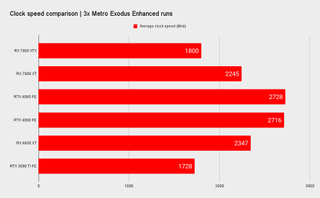
The RX 7900 XTX is surprisingly sluggish when it comes to average clock speeds collected during three runs of Metro Exodus Enhanced Edition. Its 1.8GHz reported average frequency is a far cry from the clock speeds we've come to expect from RDNA 2. And from this metric alone you wouldn't think much of AMD's claim to a card 'architected to exceed 3GHz'.
But AMD wasn't lying when it said this card is capable of 3GHz, and that's without pushing the limits of overclocking, too. For brief periods of time, blips really, the RX 7900 XTX reaches clock speeds in excess of 3GHz. I saw this card hit 3,138MHz repeatedly during Metro Exodus, though primarily during the beginning of the run. After that, the clock speed tends to gradually decline to a relatively pedestrian 1.5–2GHz.
Clearly, there's a wildly aggressive frequency curve on this card. To bounce from a 1.2GHz clock to a 3.2GHz clock across a single Metro Exodus benchmark run is immense. That's counting only the frames where the GPU is at over a 60% utilisation rate, too, excluding loading screens and downtime that might otherwise mess with the figure.
I thought initially perhaps AMD is leaving itself some headroom on the clocks for an RX 7950 XTX or similar, but then you look at the thermal performance and this card and wonder if AMD could actually pump it with any more voltage.
Thermal performance
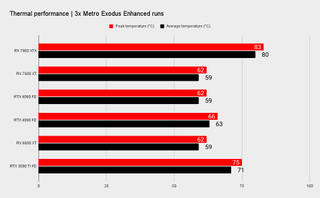
The sort of 4K performance we're seeing today has clearly not come easily to any high-end graphics card. AMD and Nvidia have had to really juice up their latest GPUs to hit new heights for performance in spite of more efficient process nodes being used to manufacture these chips. Power draw of over 300W, on average, is becoming the norm, and even though AMD's RDNA 3 architecture may be efficient clock-for-clock there's a lot stuffed into the RX 7900 XTX.
I'm surprised to see the XTX close to topping the charts in power consumption and sitting as the hottest of any card tested by a fairly large margin. The XT isn't anywhere near as hot, though is still quite hungry. Perhaps it's the lack of behemoth cooler on the RX 7900 XTX to match the RTX 4080 or RTX 4090, but this all suggests AMD has really pushed the XTX to the ragged edge to compete with the RTX 4080.
But has AMD done enough to make the RX 7900 XTX worth buying instead of spending the extra cash on the RTX 4080?
AMD RX 7900 XTX analysis

How does the RX 7900 XTX stack up?
The RX 7900 XTX is a high-end graphics card that pushes to new heights for Radeon GPUs. At 4K, this card is capable of dominating the last-gen. The RX 7900 XTX comes into its own, easily dispatching the RX 6950 XT and the RTX 3080 Ti—two plenty capable 4K cards in their own right.
This is a genuine 4K graphics card, and with the right game and the right optimisations, you can expect to actually make great use of a high-refresh rate 4K monitor. Thankfully we have a lot of those nowadays and they're even starting to become fairly affordable.
I can also see a use for one of these cards on a gorgeous ultrawide. At 1440p, this card is buttery smooth to game on. It will mostly max out a 144Hz panel on max settings or with some parsimonious tweaks.
With the right game and the right optimisations, you can expect to actually make great use of a high-refresh rate 4K monitor.
For competitive gaming, this card is genuinely hitting the limits of 1080p performance. That's true of both AMD and Nvidia's latest—it's not these cards' shaders that are holding them back, it's everything else in your PC and sometimes even the game engine itself limiting frame rates. No doubt you'll want one of the best CPUs for gaming to go with this chip to get the most out of it at lower resolutions, which makes for a holistically pricey build, but it's true that even an older, cheaper GPU can often get you close to the same performance at 1080p as the XTX. It's just not worth investing in the latest and greatest if that's your plan.
The simple conclusion to draw is if you want a 4K gaming experience, the RX 7900 XTX is a great card to do that with. But compare the card with Nvidia's lot and it's important to still consider your options.

For those sorts of PC builds, there's nothing quite able to offer what the XTX can on a $999 budget. After all, Nvidia has priced itself out of this $1,000 market, and AMD's only other option is the RX 7900 XT. The cheaper card is not a bad shout for most, but its price tag is a little too close to the XTX to leave much wiggle room on launch day.
If you're overpaying for an XT, you'll be disappointed you couldn't get a reference XTX for $999.
On that note, I'm holding out for swathes of cards available to purchase immediately after launch, but I'm not hopeful for overflowing availability—it's always a race to checkout and the more affordable MSRP cards, such as this card in reference garb, are often the first to go. On the supply front, AMD has said that it should have greater yields due to the smaller chip sizes used in the Navi 31 GPU, though historically its launch day supply is slim. We can only hope for greater supply and a stay from extreme price tags once the dust has settled post-launch.
I think the difficulty for the RX 7900 XTX will come in third-party models and launch day inflation that pushes the price far in excess of the $999 MSRP. In the RX 7900 XTX's case, the RTX 4080 isn't that far away to not be a bit threatening if prices started to trundle off well in excess of the MSRP.
Ultimately, the RTX 4080 is the target that AMD has been aiming for with the XTX, and in my testing it just doesn't reach it consistently enough to make that a favourable comparison. Not often enough, anyways. It's that age-old thing: the XTX, in the right circumstances, will make swift work of the RTX 4080, but in games few and far between. The RTX 4080 is generally the faster card from my testing.

And the RTX 4080 is more threatening for the release of DLSS 3. While limited in its scope due to a lack of support in all too many games today, the frame generation tech inherent to the newer upscaling technology is incredibly impressive. It adds heaps of performance that AMD just can't quite match right now without its own frame generation tech. Don't worry, that's coming, but it might be a while. AMD only very recently announced it's working on it.
But AMD does have its own software stack, and a capable one at that. The Radeon software package has come on leaps and bounds and now offers comparable features to Nvidia's, and the GPUOpen initiative is regularly making AMD's open-source technologies that much better. AMD's own upscaling technology, FidelityFX Super Resolution, is becoming more ubiquitous with every passing game launch, which means even AMD gamers don't miss out on the close to free performance uplift of AI upscaling.
Yet for missing the gusto to cleanly kill off Nvidia's pricey RTX 4080, the thing that really impresses me with the RX 7900 XTX is that it's a first-generation chiplet-based GPU that actually works. I feel like I've been writing about the possibility, the smallest glimmer of hope, that a chiplet-based GPU might be possible, and AMD's gone and done it. It's created a graphics card with a clever chiplet design that thankfully doesn't require a complete rework of the entire programming base for modern-day gaming. Phew.
I think there's a lot of ingenuity still left to be uncovered in chiplet-based graphics. Think of the first Zen 2 chips to where we're at now with Zen 4. As a first step towards all of that and more in graphics, I'm left seriously impressed with the trouble-free experience I've had with the first-of-its-kind RX 7900 XTX.
AMD RX 7900 XTX verdict
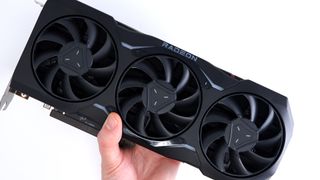
Should you buy an RX 7900 XTX?
If you're only playing Far Cry 6 then you're laughing with an XTX, but let's be honest, you're not.
Without knowing how supply and prices will fluctuate over the coming months, the RX 7900 XTX is a superb 4K GPU at its original $999 price tag. It's ruling its own segment of the market, and it offers a significant performance boost over what RDNA 2's could muster in the ~$1,100 RX 6950 XT or $999 RX 6900 XT. It's expensive, but not any dearer than the card it replaces.
Admittedly the RX 6950 XT is nowhere near its full price today, more like $800 or less. Though the RX 7900 XTX has enough pace to justify its price tag. You're paying around 20% more than an RX 6950 XT as it stands today for a card that generally outperforms it by 20% or, on a few occasions in my benchmarking, a whole lot more.
The increase in memory capacity from 16GB to 24GB with the RX 7900 XTX is a bonus, and the ray tracing performance on RDNA 3 is much more convincing to make me part with my money.
Yet as an RTX 4080 competitor the RX 7900 XTX is less convincing. It's rarely able to match the RTX 4080. The RTX 4080 is up to 28% faster in my testing, though it's more like 15% on average. For an RTX card that asks at least 20% more cash than the RX 7900 XTX, that stat is not a dealbreaker, but it does make the XTX's gains more moderate by comparison. What helps the XTX's value proposition is that it has more memory and, on rare occasions, actually beats the RTX 4080. If you're only playing Far Cry 6 then you're laughing with an XTX, but let's be honest, you're not.
This leaves Nvidia with rule of the ultra-high-end segment. But AMD has played the hand dealt to it by Navi 31's performance here. It has a card that's not regularly outperforming the RTX 4080, but it's notably cheaper. That absolutely brings the XTX back into consideration at the $1,000 mark.
If the $999 price tag on the RX 7900 XTX can meaningfully stick around for a while, and by that I mean you have to be able to buy this card for that price tag or similar, the RX 7900 XTX will exist as a great 4K graphics card for an ultra high-end PC build in 2023. Yes, there are better, and the RTX 4090 is now undeniably the top dog for gaming, but It's all about weighing up what you really need and what you can afford—i.e. probably not an RTX 4090.
Combined with a high-end CPU and a 4K (or ultrawide) monitor, you'll net superb frame rates with the RX 7900 XTX in your build for potentially half the price.
The RX 7900 XTX is not a direct competitor to the RTX 4080 in every way, but it's notably cheaper and delivers a whole lot more than the top RX 6000-series card.

Jacob earned his first byline writing for his own tech blog. From there, he graduated to professionally breaking things as hardware writer at PCGamesN, and would go on to run the team as hardware editor. Since then he's joined PC Gamer's top staff as senior hardware editor, where he spends his days reporting on the latest developments in the technology and gaming industries and testing the newest PC components.
